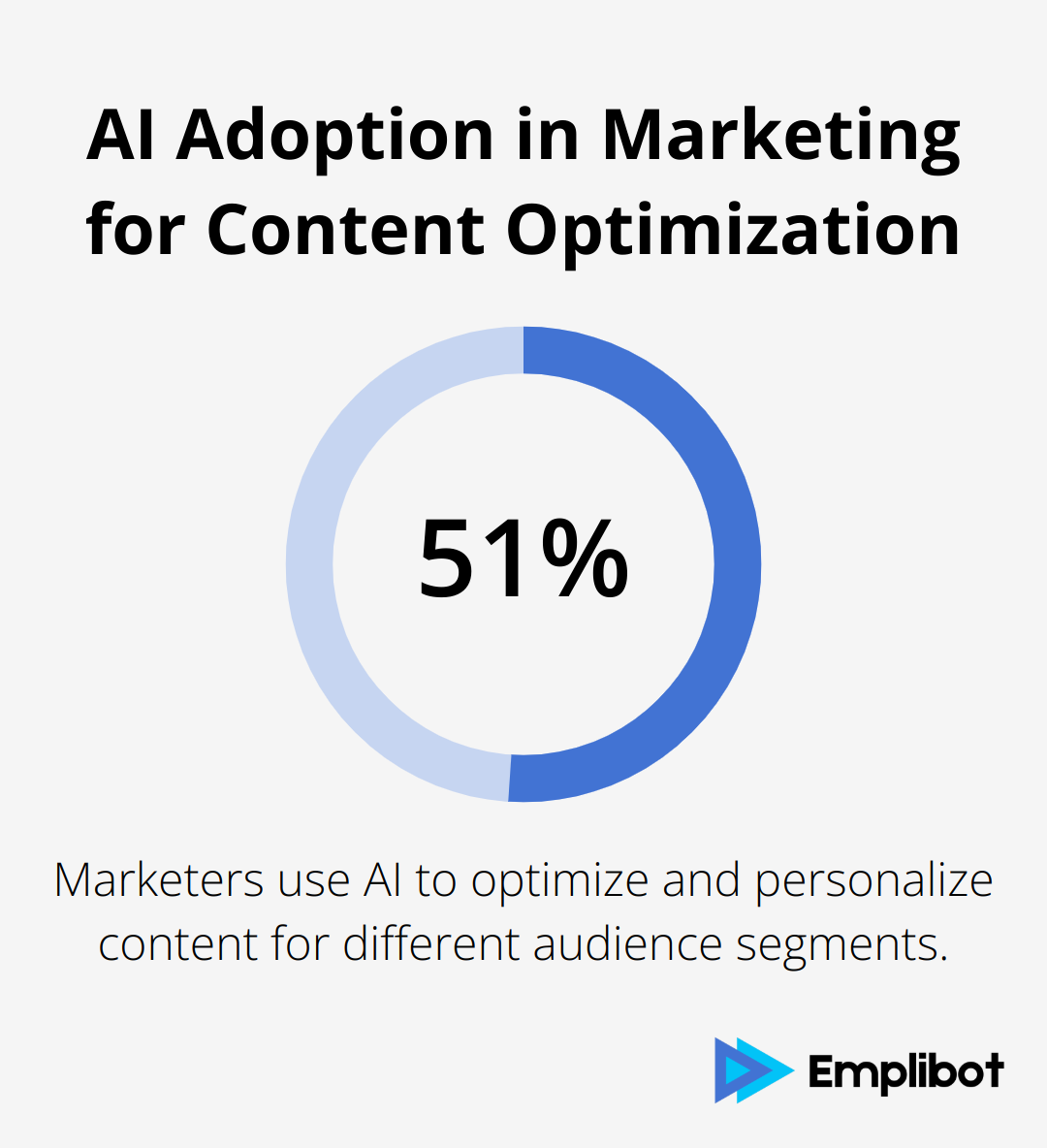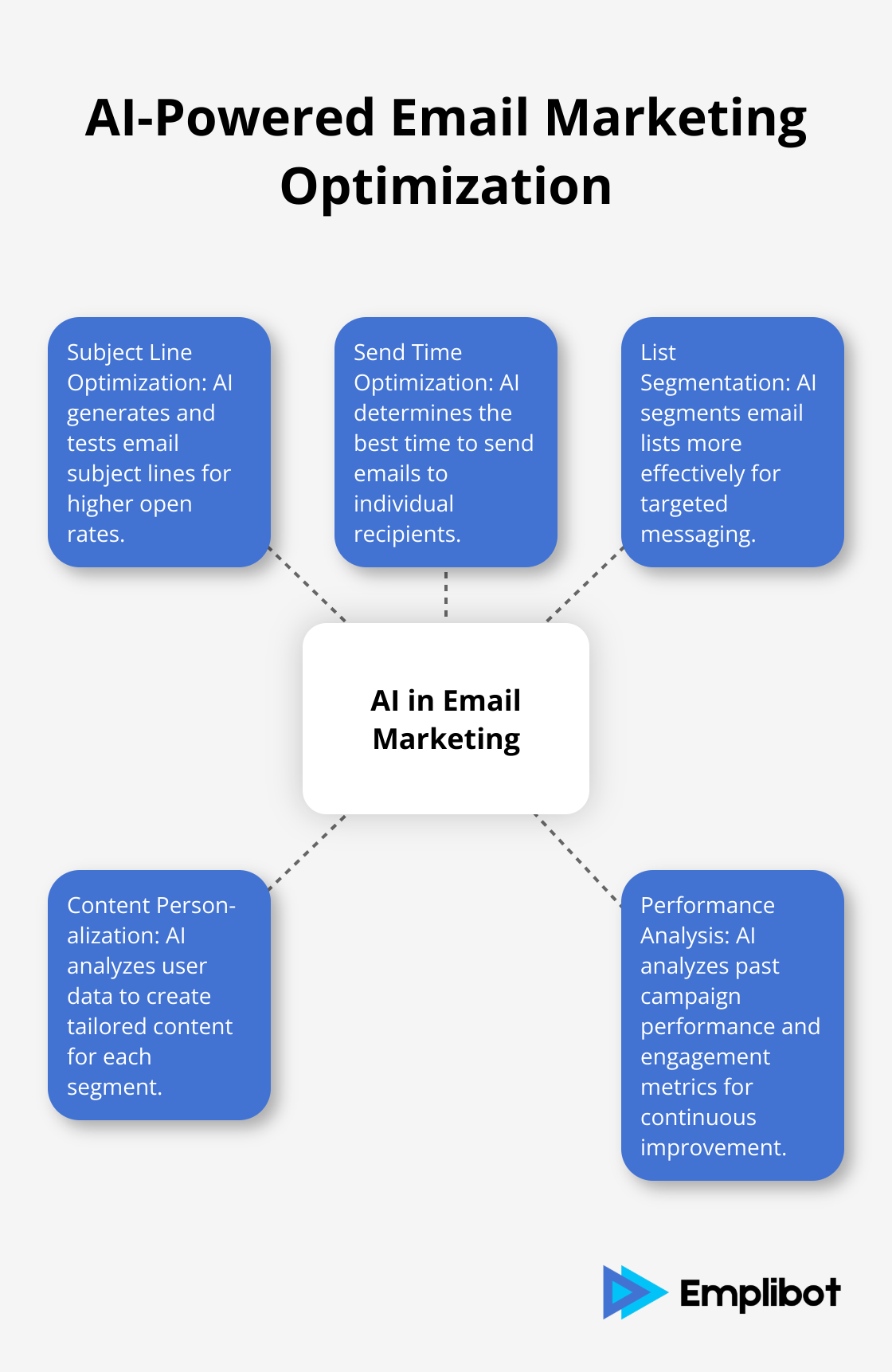AI product marketing is transforming how businesses connect with customers and promote their offerings. At Emplibot, we’ve seen firsthand how artificial intelligence can revolutionize marketing strategies and drive results.
From market research to personalized content creation, AI tools are reshaping every aspect of product marketing. In this post, we’ll explore practical ways to harness AI’s power for more effective marketing campaigns and enhanced customer experiences.
How AI Revolutionizes Market Research
AI transforms how businesses conduct market research and gain customer insights. This technology reshapes data analysis and consumer behavior prediction, offering new opportunities for marketers.
AI-Powered Market Segmentation
AI analytics tools revolutionize market segmentation. These tools process vast amounts of data from various sources (social media, purchase history, demographic information). A Salesforce study found that 51% of marketers use AI to optimize and personalize content for different audience segments.

AI identifies micro-segments within target markets, enabling hyper-targeted marketing campaigns that address specific customer needs and preferences. Netflix exemplifies this approach, using AI to create thousands of viewer segments based on viewing habits, resulting in highly personalized content recommendations.
Unraveling Customer Behavior with Machine Learning
Machine learning algorithms excel at analyzing customer behavior patterns. These algorithms can be used for personalized product recommendations, demand forecasting, and behavioral segmentation.
AI tracks customer interactions across multiple touchpoints (website visits, social media engagement) and creates comprehensive customer profiles. Marketers can use this data to predict future behavior and tailor their strategies accordingly.
Practical tip: Integrate your customer data from various sources into a single platform. This provides a more holistic view of your customers and allows AI tools to generate more accurate insights.
AI-Driven Trend Forecasting
AI’s predictive capabilities prove invaluable for anticipating market trends and consumer preferences. By analyzing historical data and current market conditions, AI forecasts future trends with remarkable accuracy.
AI-powered trend forecasting tools like Heuritech analyze millions of social media images to predict fashion trends up to one year in advance. This allows fashion brands to align their product development and marketing strategies with upcoming trends.
To leverage this capability, incorporate AI-powered trend analysis tools into your market research process. These tools provide early warnings about emerging trends, giving you a competitive edge in product development and marketing.
Balancing AI and Human Expertise
While AI provides powerful insights, human expertise remains crucial in interpreting and acting on these insights. The most effective approach combines AI’s data-crunching capabilities with human creativity and strategic thinking.
As we move forward, let’s explore how AI not only analyzes data but also creates compelling content tailored to your audience’s preferences.
How AI Transforms Content Creation
AI revolutionizes content creation, enabling marketers to produce high-quality, personalized content at scale. This technology streamlines the process of generating product descriptions, marketing copy, and email campaigns, allowing businesses to engage their audience more effectively.
Automating Product Descriptions
AI-powered tools generate product descriptions that are both accurate and compelling. These tools analyze product features, benefits, and target audience preferences to create descriptions that resonate with potential customers. For example, Shopify’s product description generator uses AI to create unique, SEO-friendly descriptions for e-commerce products, saving time and improving consistency across large product catalogs.
A study by Forrester Research found that 61% of online shoppers prefer to buy from retailers that provide custom product content. AI-driven product descriptions help businesses meet this demand efficiently and effectively.
Personalizing Content at Scale
AI enables marketers to create personalized content for different audience segments without extensive manual work. Machine learning algorithms analyze user data to understand preferences, behavior, and engagement patterns, allowing for the creation of tailored content that speaks directly to each segment.
Dell now uses AI to improve the marketing copy of their promotional and lifecycle emails, Facebook ads, display banners, direct mail, and even radio content. This level of personalization would be impossible to achieve manually at scale.
Optimizing Email Campaigns
AI transforms email marketing by optimizing various aspects of campaigns, from subject lines to send times. Tools like Phrasee use natural language processing to generate and test email subject lines that are more likely to be opened and clicked.
According to a study by Statista, personalized email marketing generates a median ROI of 122%. AI-powered tools significantly contribute to this by analyzing past campaign performance, subscriber behavior, and engagement metrics to determine the best time to send emails to individual recipients.

AI segments email lists more effectively, ensuring that the right message reaches the right person at the right time. This precision in email marketing leads to higher open rates, click-through rates, and ultimately, conversions.
Balancing Automation and Human Creativity
When implementing AI in your content creation process, it’s important to maintain a balance between automation and human creativity. While AI handles much of the heavy lifting in terms of data analysis and content generation, human oversight ensures brand voice consistency and adds that personal touch that resonates with your audience.
As we explore the next frontier of AI in product marketing, we’ll examine how this technology enhances customer experiences through innovative tools and personalized interactions. The seamless integration of AI-powered content creation with these customer-centric approaches promises to revolutionize the way businesses connect with their audience.
How AI Enhances Customer Experience
AI revolutionizes customer experience in product marketing. Let’s explore practical ways businesses use AI to improve customer interactions and drive sales.
24/7 Customer Support with AI Chatbots
AI-powered chatbots transform customer support. These intelligent assistants handle a wide range of customer queries, from product information to order tracking, around the clock. AI chatbots provide instant responses to customer queries, significantly decreasing response times.

H&M’s chatbot helps customers find products, offers style advice, and processes orders directly through the chat interface. This enhances the shopping experience and allows human customer service representatives to focus on complex issues.
To implement chatbots effectively:
- Identify the most common customer queries
- Ensure your chatbot efficiently handles these queries
- Update your chatbot’s knowledge base regularly to keep it current with product offerings and policies
Personalized Product Recommendations
AI algorithms analyze customer data to provide highly personalized product recommendations. These recommendations boost sales and customer satisfaction. Amazon uses AI to boost sales through its powerful recommendation engine, which is one of the most popular AI-backed strategies used by the company.
To implement AI-driven recommendations:
- Collect customer data (purchase history, browsing behavior, demographic information)
- Analyze this data to train machine learning models
- Use these models to predict products a customer will likely be interested in
Sephora’s Virtual Artist app uses AI to analyze a customer’s facial features and skin tone to recommend suitable makeup products. This personalization enhances the customer experience and increases purchase likelihood.
Virtual and Augmented Reality for Product Demonstrations
Virtual and augmented reality (VR/AR) technologies, powered by AI, transform how customers interact with products before purchase. These technologies allow customers to visualize products in their own environment or on themselves, reducing uncertainty and increasing confidence in purchasing decisions.
IKEA’s Place app uses AR to show customers how furniture would look in their homes before buying. Similarly, L’Oréal’s Style My Hair app uses AI and AR to let customers virtually try on different hair colors.
To implement VR/AR in your product marketing:
- Identify products that customers might hesitate to buy without seeing or trying
- Develop 3D models of these products for use in VR/AR applications
- Create an intuitive interface for customers to easily interact with these virtual products
The goal is to provide value to the customer, not just showcase technology. Your VR/AR implementations should genuinely help customers make better purchasing decisions.
Final Thoughts
AI product marketing has transformed how businesses connect with customers and promote their offerings. These advancements enable marketers to make data-driven decisions, create highly targeted campaigns, and deliver personalized experiences at scale. However, as we embrace AI in marketing, we must address potential challenges and ethical considerations such as data privacy and security.
The benefits of AI in product marketing outweigh the drawbacks. Businesses that embrace AI gain a significant competitive advantage, responding faster to market trends and providing superior customer experiences. AI-powered marketing tools like Emplibot exemplify this advantage, automating content creation and distribution across multiple platforms while maintaining quality and relevance.
AI product marketing is not just a trend-it’s the future of how businesses will connect with their customers. Marketers can unlock new levels of efficiency, personalization, and effectiveness in their campaigns by embracing AI tools and strategies. The time to act is now: harness the power of AI to transform your product marketing efforts and stay competitive in today’s rapidly evolving digital landscape.

